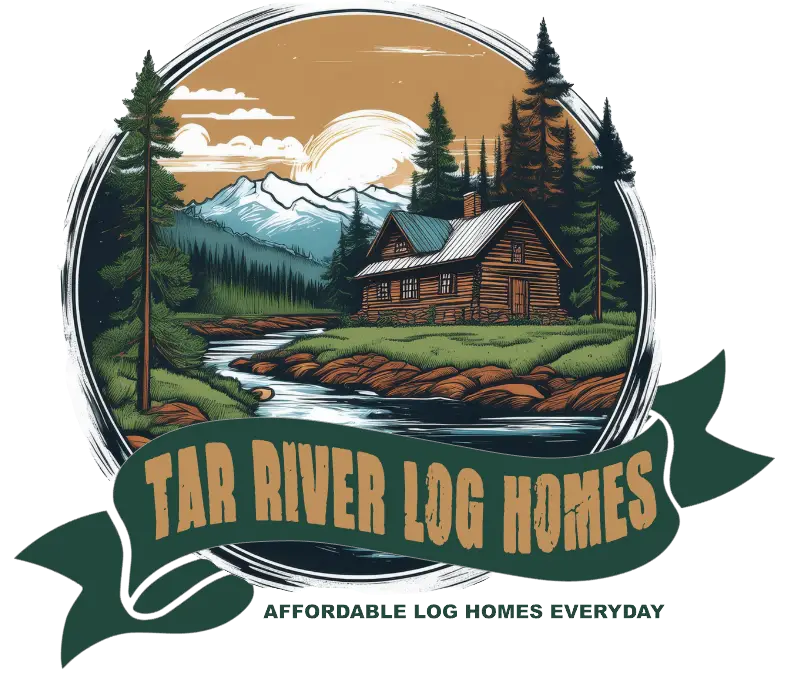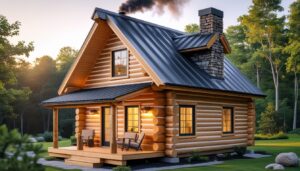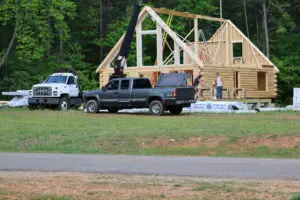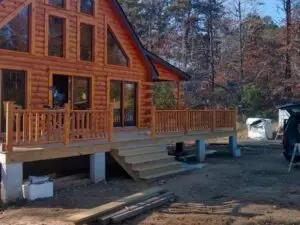Building a log home doesn’t have to drain your savings. Affordable log home kits under $50,000 let families build sturdy, welcoming spaces without breaking the bank.
At Tar River Log Homes, we believe in keeping it simple. We provide honest pricing, reliable materials, and designs that work for real families. These kits are for buyers who want control over their build, whether they do it themselves or with help.
This guide shows you what’s included in log home kits under $50K and how to choose the right one. Read on and also discover how to plan for costs, maintenance, and future upgrades.
What Are Log Home Kits Under 50K?
You can build a solid log home for less than you might expect. These kits offer practical options that balance cost, quality, and simplicity. They pack in all the basics, from cut logs to blueprints, aimed at hardworking folks ready to make their dream home happen.
Overview of Log Home Kits
Log home kits under $50,000 usually include most of what you’ll need for a simple, sturdy cabin: pre-cut logs, floor joists, roofing materials, and step-by-step instructions. These kits appeal to anyone wanting a hands-on project and a low-cost home option.
They’re smaller or more basic than luxury kits. You get a ready-to-ship package with the essentials—no last-minute surprises. These kits come in different styles, and you can tweak them to fit your needs.
Key Features at This Price Point
Kits under $50K aim for practicality. You’ll get enough wood and materials for a solid frame and exterior walls, but some interior finishes or extras might be on you.
The materials are user-friendly, and the plans are designed for straightforward builds. The idea is to give you a safe, reliable home without fancy bells and whistles.
What’s usually included:
- Pre-cut, kiln-dried logs
- Blueprint plans
- Basic roofing supplies
- Hardware (nails, screws, etc.)
You can stick to the basics or add upgrades later as your budget allows.
Common Materials Used
Most affordable log home kits use Eastern White Pine logs—they’re strong, easy to handle, and budget-friendly. These logs are kiln-dried, so you won’t deal with as much shrinking or cracking.
Besides logs, you’ll often get framing lumber, roofing panels, and fasteners. Some kits toss in insulated windows and doors, though that varies.
Costs stay lower when suppliers source directly and skip markups. That way, you’re paying for good wood, not a bunch of extras you don’t need.
Energy Efficiency in Budget Log Homes
Even budget-friendly log homes can be energy efficient. Logs naturally store and release heat, helping regulate indoor temperatures year-round. The Department of Energy notes that adding insulation in the roof and floor makes a big difference.
Choosing efficient windows and doors also keeps drafts out and bills down. Affordable upgrades like weatherproof sealant and quality stain help protect against heat loss and moisture damage for years to come.
Types of Log Home Kits Under 50K
When you’re shopping for log home kits under $50,000, you’ll notice a few different styles. The way the logs are prepped and assembled makes a difference in cost and how much work you’ll do. Knowing the differences helps you pick what matches your skills and wallet.
Pre-Cut Log Kits
Pre-cut log kits use logs that machines have already cut and shaped to fit together. The kits come with step-by-step instructions and all the parts, so even beginners can get started. The logs are uniform and straight, which gives a neat, modern look.
You’ll save time and cut down on waste since everything’s measured before it arrives. Pre-cut kits are usually more affordable and still of solid quality.
Milled Log Kits
Milled log kits use logs shaped into consistent sizes, often with grooves or tongue-and-groove joints. This means tight-fitting walls that stand up to weather. Milled kits might cost a bit extra, but you get better insulation and stability.
The logs are smooth on all sides, so stacking and sealing are a breeze. You might see options for corner notches or chinking profiles. If you want energy efficiency and don’t want to mess with heavy tools, milled kits are worth a look.
Handcrafted Log Kits
Handcrafted log kits use logs shaped by hand for a natural, rustic vibe. They take longer to prep since each log gets checked and peeled by pros. These kits show off American craftsmanship, but usually sit at the higher end of the budget.
Handcrafted kits might be smaller or need a bit more elbow grease when you build. If you’re after character and tradition, this is your lane.
How to Choose the Right Log Home Kit
Picking a log home kit is all about matching size, design, and personal touches to your needs and budget. You want plans that fit your lifestyle, layouts you’ll actually use, and room to make it yours.
Understanding Floor Plans
Floor plans lay out the rooms and flow of your log home. Look for plans with clearly marked bedrooms, bathrooms, kitchen, and living spaces.
Think about your daily routine. Like to entertain? An open kitchen-living area is great. Need privacy? Separate rooms might be better.
Pick a plan that’s not too big or too cramped. Some kits come with a few options, so you can find one that works for you.
Sizing and Layout Options
Size affects both comfort and cost. Kits under $50,000 usually cover small to medium homes—think 1-3 bedrooms, straightforward designs. Smaller homes keep material and shipping costs down.
You’ll see single-story cabins or two-floor layouts. Single-story is usually easier and cheaper to build. Adding a second floor gives you more room but takes more work and materials.
Don’t forget storage and utility space. A smart layout means you won’t feel boxed in—or pay for rooms you never use.
Customization Possibilities
A lot of log home kits start with a basic design, but let you customize. Maybe you want more windows, a porch, or a different room size. Some companies let you choose how the logs fit, pick door and window styles, and tweak other details.
You’re not locked into the first floor plan you see. Customization helps you make it yours without surprise costs. Just ask what’s included and what might bump up your budget before you commit.
Top Manufacturers and Brands
If you’re after log home kits under $50,000, you want brands that hit the sweet spot between price and quality. Some companies stand out for reliable materials and customer support. Knowing your supplier makes a difference.
Popular U.S. Companies
Plenty of U.S. companies sell affordable log home kits made from local wood. These folks focus on giving you good materials without showroom markups.
You’ll find ready-to-build packages with clear instructions. Some let you tweak the layout, so you’re not stuck paying for stuff you don’t need. Kiln-dried logs are common, which helps prevent warping.
Tar River Log Homes keeps prices down by shipping direct—no middlemen. They offer strong logs and honest pricing. Their 105% price guarantee means you know you’re getting a straight deal.
International Suppliers
Some international companies offer log home kits at lower prices thanks to cheaper labor or wood. Sounds good, but shipping and import fees can add up fast.
Quality can be hit-or-miss overseas, and getting help or replacement parts might be tricky. If you go international, check for kiln-dried wood and solid instructions. Some offer European-style cabins with different looks and building methods.
They’re unique, but you might need extra tools or skills. Choosing between U.S. and international brands comes down to cost, quality, and support. If you want a smooth build and dependable materials, U.S. companies usually make things easier.
Budgeting for Your Log Home Kit
Budget planning is huge when you’re eyeing a log home kit under $50,000. Don’t forget to factor in costs beyond the kit itself. Comparing these with other home types can help you decide where your money’s best spent.
Hidden Costs to Consider
The kit price might look great, but extras can sneak up on you. Delivery fees depend on your location. Prepping the site—removing trees, leveling land—can add thousands. You’ll also need to budget for plumbing, electrical, and insulation, since most kits don’t include those.
Permits and inspections can run a few hundred bucks, depending on local rules. If you’re building yourself, don’t forget tools and supplies. Sometimes you’ll need pros for tricky stuff like roofing or foundations. Knowing these extras keeps you from getting blindsided.
Cost Comparison With Other Housing Options
A log home kit under $50,000 is often cheaper than a traditional stick-built house or a manufactured home. Stick-built homes usually mean higher labor and material costs.
Compared to manufactured homes, log cabins offer natural insulation and durability—potentially saving on heating and cooling. Building a log home might take longer, though, which could mean extra costs for labor or a place to stay during construction.
If you want something simple and sturdy, a kit from a trusted seller is a solid value. You pay less for quality logs and save on contractors if you’re willing to do some work yourself. That balance can beat the hidden costs of other housing choices.
Step-by-Step Assembly Process
Starting your log home kit goes smoothly with a plan. You’ll need to prep the land, check your delivery, and organize materials to keep things on track.
Preparing the Site
Pick a flat, level spot for your cabin. Clear out trees, rocks, and debris so you’ve got a clean work area. Make sure the ground drains well—nobody wants a soggy foundation.
Mark your foundation using the log home plans. Stakes and string lines help you lay things out. Double-check your measurements before digging or pouring concrete.
Plan for utilities like water and electricity if you’ll need them. It’s easier to do this early. Keeping your site tidy helps with safety and sanity throughout the build.
Delivery and Unpacking
When your kit arrives, go through the crates carefully. Match everything to the packing list—missing parts are a pain to chase down later. Lay out logs by size and type near the build site, but keep things organized to avoid damage.
Smaller hardware goes in clear containers or boxes so you don’t lose track. Take your time here—handling materials with care protects your investment and saves headaches down the road.
Do-It-Yourself vs. Professional Assembly
One big decision: build it yourself or hire a pro? Each option needs a different time, tools, and skills. Some folks want help with the tricky parts, others want to save cash and do it all.
Tools and Skills Required
If you’re doing your own log home assembly, you’ll need basics like a drill, saw, level, and hammer. Safety gear (gloves, goggles) is a must. Advanced tools like a chainsaw or nailer help, but aren’t always needed.
You should be comfortable reading blueprints and measuring accurately. Carpentry or construction experience makes things easier and safer. Fitting logs tightly and sealing them against the weather takes some know-how. If you’re new, expect a learning curve and give yourself more time.
Benefits of Professional Help
When you hire pros, your log home usually comes together faster and with fewer headaches. They know how to handle tricky details—corners, roof framing, sealing—all that stuff that can trip you up if you’re not careful.
If you need permits or inspections, professionals can guide you through the maze. That saves you from expensive holdups. You still get to pick out your own style and materials, but you’re not stuck sweating the tough parts or measuring twice (and still getting it wrong).
If you care about time and want a polished look, it’s honestly worth paying for assembly. You’ll probably sleep better and have more energy to focus on the fun parts of the building process.
Financing Options for Log Home Kits
Paying for your log home kit doesn’t have to be a nightmare. There are a few solid routes, whether you want to borrow or just use your own savings. Picking what works for your wallet and your plans helps you dive in without second-guessing everything.
Loans and Financing Programs
Home improvement loans or construction loans can cover your kit and all the extras. Usually, these loans pay for the kit and leave room for supplies. Rates bounce around, so it pays to shop a little.
Most lenders want a down payment, usually 10–20%. You’ll need to show proof of income and maybe a build plan. Some loans let you pay just interest while you’re building, which can make the start a bit easier.
If your credit’s good, you might get a personal or credit union loan, but rates aren’t as low as with a mortgage.
Using Personal Savings
Paying with savings means no loan stress, no interest, no bank breathing down your neck. You’re in charge, so the build moves at your pace.
Determine a budget based on your kit, plus any additional expenses such as delivery or foundation work. Always keep a little cash stashed for unexpected expenses.
Many clients save up over time for a kit. You avoid debt and usually end up spending less, especially if you’re disciplined about sticking to your plan.
Common Challenges and Solutions
Building a log home kit for under $50,000 isn’t always smooth sailing. Zoning, building standards, and tough weather can throw curveballs. You’ve got to stay sharp to make your home last.
Zoning Laws and Building Codes
First things first, check your local zoning laws before you buy. Some places limit size, height, or even the style of home. Permits might be required before you can do anything.
Building codes set the rules for wiring, insulation, and more. These rules change depending on where you live, so get familiar with them early. If you’re not sure, ask a local contractor or even your kit supplier.
Make sure your plans line up with local rules. It’s better to get approvals before you order materials and start building.
Weatherproofing Your Log Home
Log homes need solid protection from rain, snow, and wind. Logs move with the weather, so proper sealing and chinking matter if you want to keep air and water out.
A good stain or sealant protects your logs from moisture—just remember to reapply every few years. Check your roof and gutters regularly to catch leaks before they become problems.
Insulation is worth it. Even though logs hold some warmth, adding insulation to the roof and floors keeps your place comfortable and saves on bills.
Success Stories: Real Log Homes Under 50K
Plenty of folks have built sturdy, inviting log homes for under $50,000. Their stories (and their before-and-after photos) give a real sense of what’s possible and how to stretch your dollars.
Homeowner Experiences
Some families have pieced together their cabins from starter kits. One couple in North Carolina kept it under $45,000 by picking a smaller plan and rolling up their sleeves for most of the build. They said, “The materials were solid, and we appreciated that the price was clear with no surprises.”
Another family went with Eastern White Pine logs and simple designs to keep costs low. They recommend careful planning and love how their home feels sturdy and warm, even in winter.
Many people mention the no-gimmicks pricing and wholesale direct shipping as a significant help to their budgets. You receive straightforward support and logs that fit together seamlessly.
Before and After Photos
Pictures tell the story better than words. You’ll see empty lots or old trailers in the “before” shots. The “after” photos show real progress—stacked logs, solid roofs, finished porches.
These images make it easier to imagine your own build taking shape. The kits arrive ready to stack, so you’re not stuck figuring it all out from scratch.
Here’s what you might notice in these photos:
| Stage | Visuals Showing | What It Means for You |
| Before | Cleared land, foundation dug | Ready for hard work and focus |
| Mid-Build | Logs stacked, windows framed | Step-by-step progress in a clear plan |
| Finished Home | Painted exterior, furnished porch | Cozy living space, budget-friendly |
Future Trends in Affordable Log Homes
Customization is getting bigger. More log home kits let you pick layouts and materials, so you pay for what you want—not for stuff you’ll never use.
Sustainable materials are showing up more often, too. Builders are looking at eco-friendly logs and insulation, which saves energy and money over time. Technology’s creeping in, for the better. Expect more 3D plans and online tools to make building less intimidating.
Step-by-step instructions are becoming the norm. A top company keeps pace with these trends, offering easy-to-build kits and clear plans. They stick to honest pricing, so hidden fees do not blindside you.
Looking ahead, Tar River Log Homes blends old-school craftsmanship with modern living. You get tough, affordable homes that actually fit your life. DIY-friendly kits are popping up everywhere.
Ready to turn your cabin dream into a plan? Explore our affordable log home kits under $50K and see how simple it can be to build a place of your own.
Frequently Asked Questions
You want a log home kit that fits your budget without compromising on quality. There are plenty of choices—small cabins, prefab kits, and Amish-built cabins. Knowing what sets them apart helps you get the most bang for your buck.
What are the best small cabin kits available for under $25,000?
Small cabins under $25,000 usually stick to simple, practical layouts. Most kits focus on easy assembly and come with logs, roofing, doors, and windows. Look for quality wood like Eastern White Pine—it lasts.
How do pre-built cabins priced under $30,000 compare in quality to log home kits?
Pre-built cabins under $30,000 are quicker to set up but might use lighter materials or offer less flexibility. Log home kits give you more say over materials and often use thicker logs, which means better insulation and long-term durability.
Can I find Amish-built cabins for less than $20,000 that are ready to install?
Amish-built cabins are usually pricier because of the craftsmanship and materials. Finding one under $20,000 is tough unless you go really small or basic. They’re built to last, but you might have to pay extra for delivery or set-up.
What are the most cost-effective log cabin kits on the market?
The best deals mix affordable materials with simple builds. Kits with pre-cut, kiln-dried logs and straightforward designs cost less. Tar River Log Homes keeps it honest—no hidden fees, just solid value for hardworking families.
Are there any prefab cabin options within the $50,000 budget?
Yes, you can find prefab cabins under $50,000 that include all the essentials, preassembled or ready to build. These kits save you time and usually come with detailed instructions. You get good materials without paying for a bunch of extras.
What should I consider when looking for a quality log cabin kit under $100,000?
If you’re shopping for a log cabin kit under $100,000, a few things matter more than you might expect. The type of logs—are they kiln-dried, green, or something in between? That can really affect how your cabin holds up over time. Moisture control is another biggie; nobody wants a soggy cabin.
Look closely at what’s actually included—roofing, insulation, maybe even windows? Some kits toss in extras, others make you hunt for them later. Instructions should be clear (unless you love puzzles), and decent customer support makes a world of difference if you hit a snag.
Oh, and make sure the pricing is straightforward. Hidden costs? No thanks.




